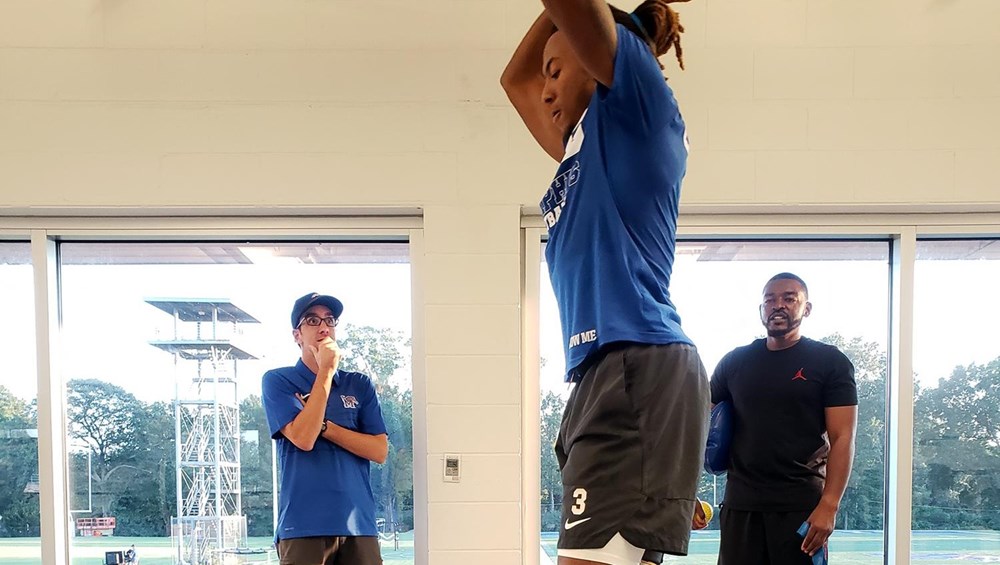Human Performance Center
Athletic Rehabilitation Support
Working hand in hand with athletic trainers and strength and conditioning coaches in Tigers Athletics, athlete rehabilitation applies scientific measurement tools to injury recovery to improve the speed and quality of therapy as athletes move from injured, to recovering to peak performance in their sport. Using a variety of specialized measurement tools the specific level of improvements are measured in lab and sport settings to ensure athletes and coaches have understanding and confidence in the rehabilitation process before returning to competition settings.

Athletic Rehabilitation Support Projects
Tracking Bone Loading Using Inertial Sensors
Tigers athletic training bringing science to the fields and courts
A new program is bringing together sports science and athletics at the University of Memphis. The program tracks bone loading using inertial sensors that can be worn around the ankles or wrists. The data gathered is used to help athletes learn how much force they are putting on their joints and how to bone load appropriately, even when walking to class.
READ MORE >ACL Rehabilitation - Supporting the Athletic Trainer with Data (Multiple Sports)
Tracking improvement every day, every session, every repetition to help athlete recovery*
To compliment monthly lab strength tests, Inertial Measure Units (IMU’s) were placed on the athlete’s lower legs to accurately track lower leg shock during every on-field training session. In collaboration with the athletic trainer, this information was used to track the total load improvements from week to week, measure the effectiveness of each session, redesign each drill and tailor the rehabilitation program specifically to the individual.
Key Finding: Engaging the athlete with data enhanced buy-in to drills and improved communication between trainer and athlete as they tracked improvement of the injured limb all the way until the athlete returned to competition.
Coach + Athlete Practical Implication: Data acts as a great ‘common language’ to helps athletes understand. Data also helps understand slight variations our eyes can’t see to ensure training is getting the planned outcome at all times.
* This was the same method used with NBA player Joel Embiid during his recovery from lower limb injury and is the first time this technology has been used within a U.S. college setting.
Using Data to Improve the ‘Return to Run’ Process (Cross Country)
Using visual data displays to help athletes relearn fundamental skills
When athletes return from a lower limb injury, there is a natural tendency to not properly load the previously injured leg, even upon full clearance from medical staff. In highly repetitious tasks in which overuse injuries are common, such as running, it is even more important to return the body to full balance as soon as possible when returning to training. Using inertial measurement units placed on the lower leg, athletes received asymmetry data after every run session to help balance right and left leg loading throughout the entire run.
Key Finding: While every athlete has a natural imbalance, keeping this below 4% was crucial in reducing the rate of reinjury.
Coach + Athlete Practical Implications: Presenting the athlete with data helped athletes recalibrate ‘even’ loading following injury. Combining ‘data’ with ‘feel’ enables athletes to learn and adapt quickly.
Lisfranc Rehabilitation - Supporting the Athletic Trainer with Data (Football)
Speeding up the recovery process with scientific data
Following a foot injury and surgery, the collaboration between applied scientists of the HPC and athletic trainers was used to ensure a fast and effective recovery. Multiple scientific measurement tools were applied - GPS to measure overall training load and return to maximum velocity, lower leg inertial measurement units to measure leg loading and return to balance, and pressure insoles to ensure an even loading of force a ross the foot during ground contacts. These multiple pieces of information were used to create a comprehensive analysis of the athlete at all stages of recovery and informed return-to-play decisions.
Key Finding: Multiple data sets combined to provide a comprehensive analysis of the athlete at every step of the recovery.
Coach + Athlete Practical Implications: Understanding the strengths and limitations of measurement devices is crucial in interpreting the performance and ability of athletes.
